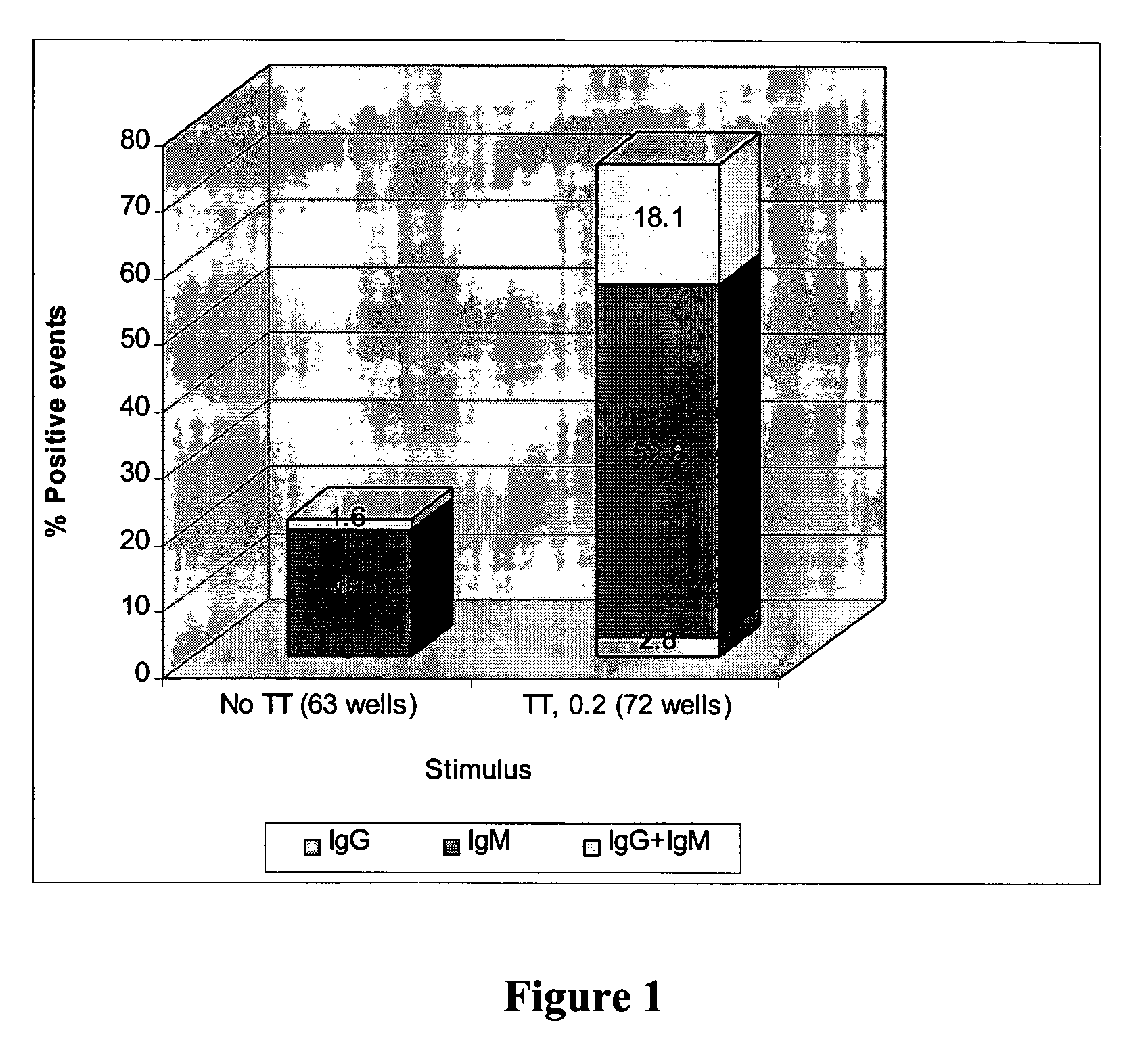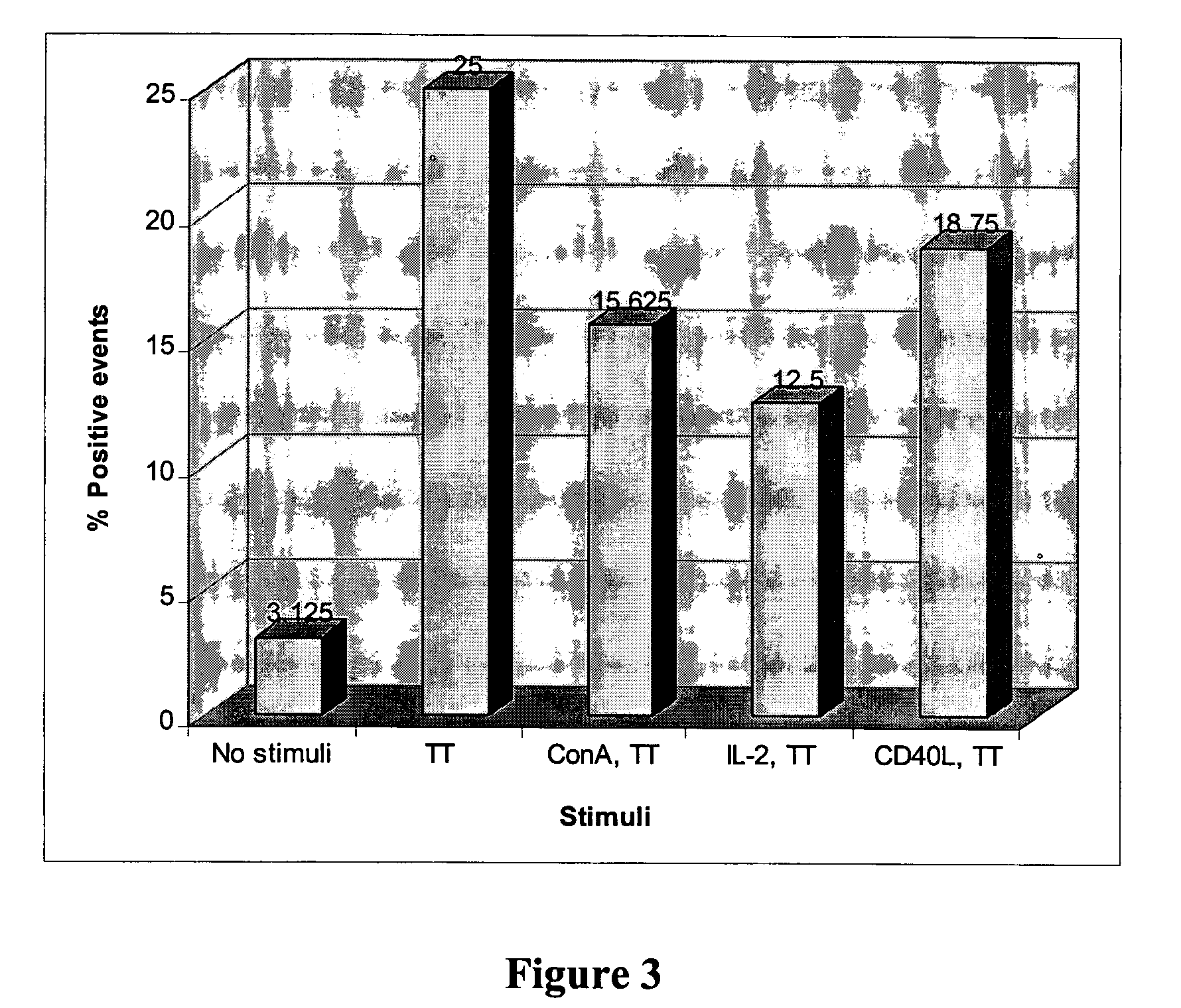Methods of generating high-production of antibodies from hybridomas created by in vitro immunization
a technology of hybridoma and antibody, which is applied in the field of hybridoma cell generation, can solve the problems of loss of binding affinity due to conformational changes in the three-dimensional structure, inability to restore the hab, and very time-consuming process, and achieves the effect of further enhancing the mutation ra
- Summary
- Abstract
- Description
- Claims
- Application Information
AI Technical Summary
Benefits of technology
Problems solved by technology
Method used
Image
Examples
example 1
Generation of Hybridomas Secreting Human Monoclonal Antibodies to Tetanus Toxin (TT)
A. Generation and Assaying of TT-Specific B Lymphocytes
[0220]Isolation of lymphocytes from Donor. Lymphocytes were isolated from whole blood by centrifugation through Ficoll-Paque according to the manufacturer's instructions. Isolated lymphocytes were incubated with 0.25 mM Leu-Leu methyl ester hydrobromide (LLOMe) prepared in RPMI 1640 medium containing 2% fetal bovine serum (FBS) for 15 minutes at room temperature. The cells were then washed three times with culture medium.
[0221]In vitro stimulation of isolated lymphocytes The cells were incubated at 37° C. in a incubator, supplied with 8% CO2, at a density between 2.5 to 5×106 cells / ml in culture medium supplemented with 10% FBS and TT and IL-2 at various concentrations. After four days of culture, the cells were washed four times with medium and the culture was continued for additional eight days.
[0222]Measurement of the B cell response. Lymphocy...
example 2
Generation of Hybridomas Secreting Human Monoclonal Antibodies to Epidermal Growth Factor Receptor (EGFR) (Self Antigen)
A. Generation of EGFR-Specific B Lymphocytes
[0227]Preparation of Antigen. Human epidermal growth factor receptor (EGFR), purified from A431 cells, was purchased from Sigma. Previous studies found that immune responses to this antigen were very weak, most likely due to tolerance. In order to enhance immunization, we conjugated the EGFR to tetanus toxin C (EGFR-TT) and the conjugate was used as immunogen for in vitro immunization in order to overcome any immunotolerance.
[0228]Preparation of EGFR-TT conjugate. 100 ug of purified EGFR was reconstituted in 100 ul of sterile MilliQ-grade water. 1 mg of purified, lyophilized recombinant tetanus toxin C fragment (TT-C) was dissolved in sterile MilliQ-grade water to yield a 2 mg / ml TT-C solution. Crosslinking was performed in 50 mM sodium carbonate buffer pH 9.0 at equimolar ratios of EGFR to TT-C, using glutaraldehyde at a...
example 3
A. Isolation of PBMC from Whole Blood
[0233]Approximately 200 ml of whole blood mixed with 200 ml PBS− / − was centrifuged through Ficoll-Paque at 2000 rpm for 30 min. Serum was aspirated, the interface layer containing lymphocytes was collected and diluted 1:3 with PBS− / − and centrifuged at 2000 rpm for 10 min. The supernatant fluid was aspirated and the pellet was resuspended in 10 ml PBS− / −. The cell suspension was split into two 50 ml conical tubes and PBS / − was added to each tube to adjust the volume to 35 ml each. The tubes were centrifuged at 800 rpm for 7 minutes to remove the platelets. After aspirating the supernatant fluid, the pellet was resuspended in 10 ml ACK Lysing Buffer and incubated for 5 minutes at room temperature. Following lysis, 35 ml PBS− / − was added to the tubes and the tubes were centrifuged at 1000 rpm for 7 minutes. The cells were then washed with 45 ml RPMI medium.
B. Preparation of Dendritic Cells
[0234]Cells were centrifuged at 1000 rpm for 7 minutes and r...
PUM
| Property | Measurement | Unit |
|---|---|---|
| temperature | aaaaa | aaaaa |
| pH | aaaaa | aaaaa |
| concentration | aaaaa | aaaaa |
Abstract
Description
Claims
Application Information
 Login to View More
Login to View More - R&D
- Intellectual Property
- Life Sciences
- Materials
- Tech Scout
- Unparalleled Data Quality
- Higher Quality Content
- 60% Fewer Hallucinations
Browse by: Latest US Patents, China's latest patents, Technical Efficacy Thesaurus, Application Domain, Technology Topic, Popular Technical Reports.
© 2025 PatSnap. All rights reserved.Legal|Privacy policy|Modern Slavery Act Transparency Statement|Sitemap|About US| Contact US: help@patsnap.com



